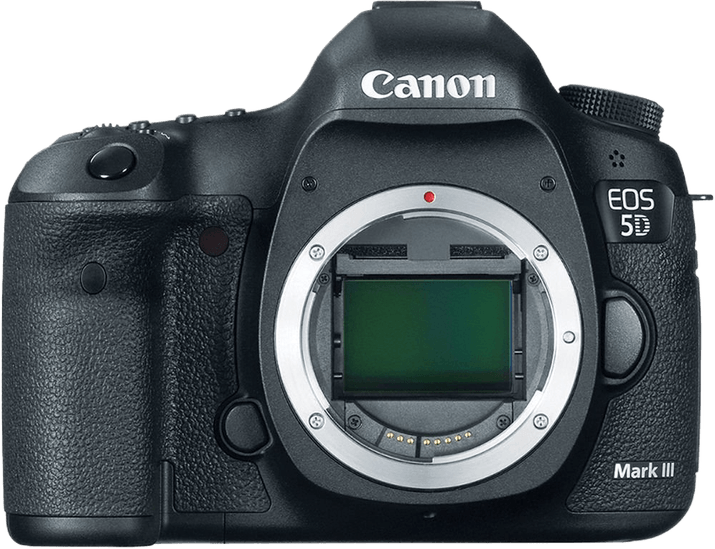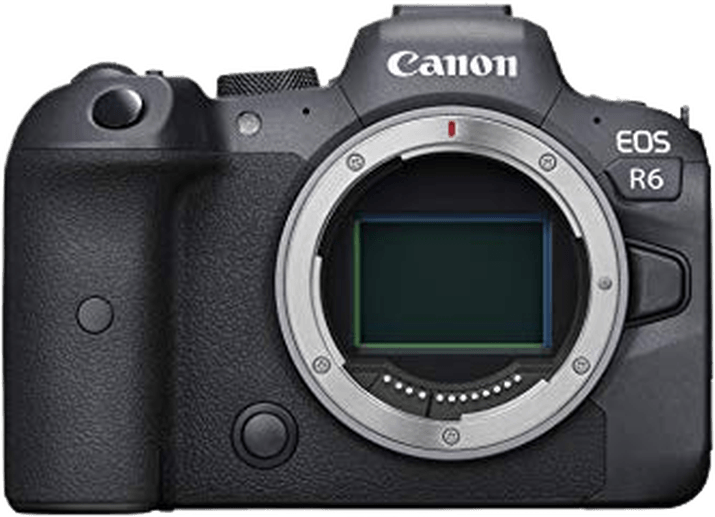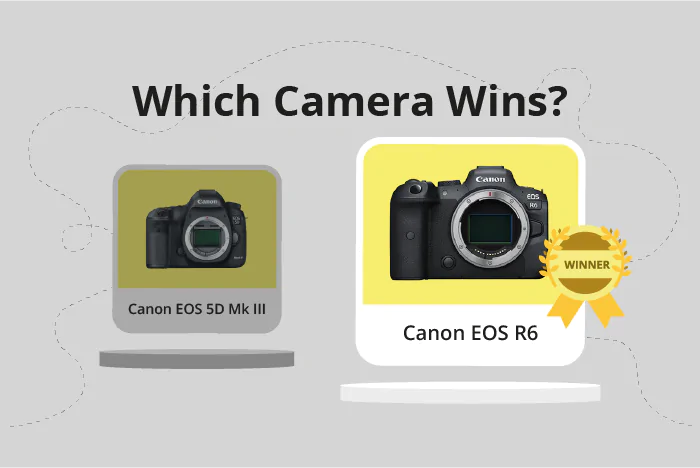Canon EOS 5D Mark III vs EOS R6 Comparison
Canon EOS 5D Mark III

Canon EOS R6

The Canon EOS R6 emerges as the winner with a score of 80/100, while the Canon EOS 5D Mark III trails behind with a score of 65/100. Both cameras share common specifications including their manufacturer, Canon, and their full-frame sensors.
The EOS R6 outshines the 5D Mark III with its mirrorless design, which makes it lighter at 680g, and more compact with dimensions of 138 x 98 x 88mm. Additionally, it has a lower launch price of $2499 compared to the 5D Mark III’s $3499.
On the other hand, the 5D Mark III, a DSLR, has a heftier build weighing 950g and larger dimensions of 152 x 116 x 76mm. Despite its lower score, it remains a reliable choice for those who prefer DSLR cameras.
Taking these factors into account, the Canon EOS R6 offers better value with its more advanced design and affordability, while the Canon EOS 5D Mark III caters to DSLR enthusiasts.
Canon EOS 5D Mark III vs EOS R6 Overview and Optics
The Canon EOS R6 outperforms the Canon EOS 5D Mark III in optics, with a score of 79/100 compared to the 5D Mark III’s 67/100. Both cameras share some similar specifications, such as the CMOS sensor type, full-frame sensor size, and megapixels, with the 5D Mark III offering 22.3 and the R6 offering 20.1. Despite these similarities, the EOS R6 surpasses the 5D Mark III in several key aspects.
The R6’s higher score stems from its faster shooting speed of 20 frames per second (fps), compared to the 5D Mark III’s 6 fps. Additionally, the R6 features a more advanced Digic X processor, resulting in improved image processing capabilities. The R6 also boasts a higher DXOMARK sensor score of 90, compared to the 5D Mark III’s score of 81, which reflects the R6’s superior image quality. Furthermore, the R6 utilizes the Canon RF lens mount and offers image stabilization, while the 5D Mark III relies on the older Canon EF lens mount and lacks image stabilization.
However, the 5D Mark III does have a slight advantage in terms of megapixels, with 22.3 compared to the R6’s 20.1. This difference may benefit photographers who require larger image sizes for printing or cropping purposes.
Taking these factors into account, the Canon EOS R6 emerges as a more advanced and capable camera in terms of optics when compared to the Canon EOS 5D Mark III. The R6’s faster shooting speed, better processor, higher sensor score, and additional features such as image stabilization make it a superior choice for photographers seeking optimal image quality and performance. While the 5D Mark III offers a slightly higher megapixel count, the R6’s other advantages outweigh this minor edge.
Canon EOS 5D Mark III vs EOS R6 Video Performance
The Canon EOS R6 outperforms the Canon EOS 5D Mark III in video capabilities, scoring 91/100 compared to the 5D Mark III’s 56/100. Both cameras share some common specifications, but the EOS R6 offers significant improvements in video quality and features.
Both the Canon EOS 5D Mark III and the Canon EOS R6 have Full HD video resolution. However, the EOS R6 also offers 4K video resolution, with maximum dimensions of 3840 x 2160, compared to the 5D Mark III’s 1920 x 1080. This means the EOS R6 provides four times the video resolution of the 5D Mark III, resulting in sharper and more detailed footage.
The EOS R6 also boasts a higher maximum video frame rate at 120fps, whereas the 5D Mark III’s maximum is 60fps. This allows the EOS R6 to capture smoother slow-motion footage and gives users more creative flexibility when shooting videos.
Additionally, the Canon EOS R6 has built-in time-lapse functionality, which the 5D Mark III lacks. This feature enables users to easily create stunning time-lapse sequences without needing additional equipment or software.
The Canon EOS 5D Mark III does not have any specific advantages in video capabilities over the EOS R6. The R6’s superior video quality, higher frame rate, and built-in time-lapse functionality make it the clear winner in this comparison.
Considering these factors, the Canon EOS R6 is the better choice for videographers and content creators who need high-quality video features. The EOS 5D Mark III, while still a capable camera, falls short in comparison to the R6’s advanced video capabilities.
Canon EOS 5D Mark III vs EOS R6 Features and Benefits
The Canon EOS R6 outperforms the Canon EOS 5D Mark III, scoring 85/100 in features compared to the 5D Mark III’s score of 59/100. Both cameras share a few specifications in common, such as screen size (3.2 inches for the 5D Mark III and 3 inches for the R6) and the lack of GPS. However, the R6 surpasses the 5D Mark III in several aspects that contribute to its higher score.
The EOS R6 has a higher screen resolution at 1,620,000 dots, while the 5D Mark III has 1,040,000 dots, providing the R6 with a sharper and clearer display. Moreover, the R6 has a touchscreen, making it more user-friendly and easier to navigate, in contrast to the 5D Mark III, which lacks this feature. The R6 also has a flip screen, allowing for more versatile shooting angles and better framing, unlike the 5D Mark III.
In terms of connectivity, the EOS R6 offers Wi-Fi and Bluetooth capabilities, enabling easy sharing and remote control of the camera. The 5D Mark III does not have these features, making it less convenient for wireless connectivity and file transfer.
Despite the lower score, the 5D Mark III has a slightly larger screen size, which some users may prefer. However, this advantage is minimal compared to the numerous benefits offered by the R6.
Given the comparison, it is evident that the Canon EOS R6 is a superior camera in terms of features when compared to the Canon EOS 5D Mark III. The R6’s higher resolution, touchscreen, flip screen, and wireless connectivity make it the clear winner. Although the 5D Mark III has a marginally bigger screen, it does not outweigh the advantages provided by the R6.
Canon EOS 5D Mark III vs EOS R6 Storage and Battery
The Canon EOS 5D Mark III wins the storage and battery comparison with a score of 76/100, while the Canon EOS R6 scores 68/100. Both cameras have two memory card slots and accept SD, SDHC, and SDXC cards. The 5D Mark III also accepts Compact Flash and UDMA cards, giving it an advantage in storage versatility.
The 5D Mark III notably outperforms the R6 in battery life, with 950 shots per charge compared to the R6’s 360 shots. They both use LP-E6 batteries, but the R6 uses the upgraded LP-E6NH version. A key advantage for the R6 is its USB charging capability, which the 5D Mark III lacks.
Considering the storage and battery aspects, the 5D Mark III offers better battery life and storage options, while the R6 provides the convenience of USB charging.
Canon EOS 5D Mark III vs EOS R6 – Our Verdict
Are you still undecided about which camera is right for you? Have a look at these popular comparisons that feature the Canon EOS 5D Mark III or the Canon EOS R6:

